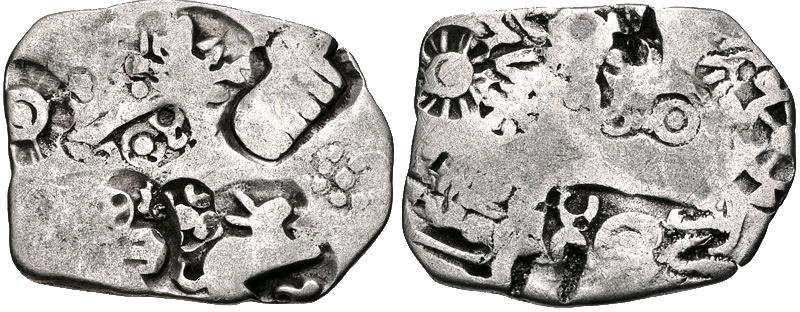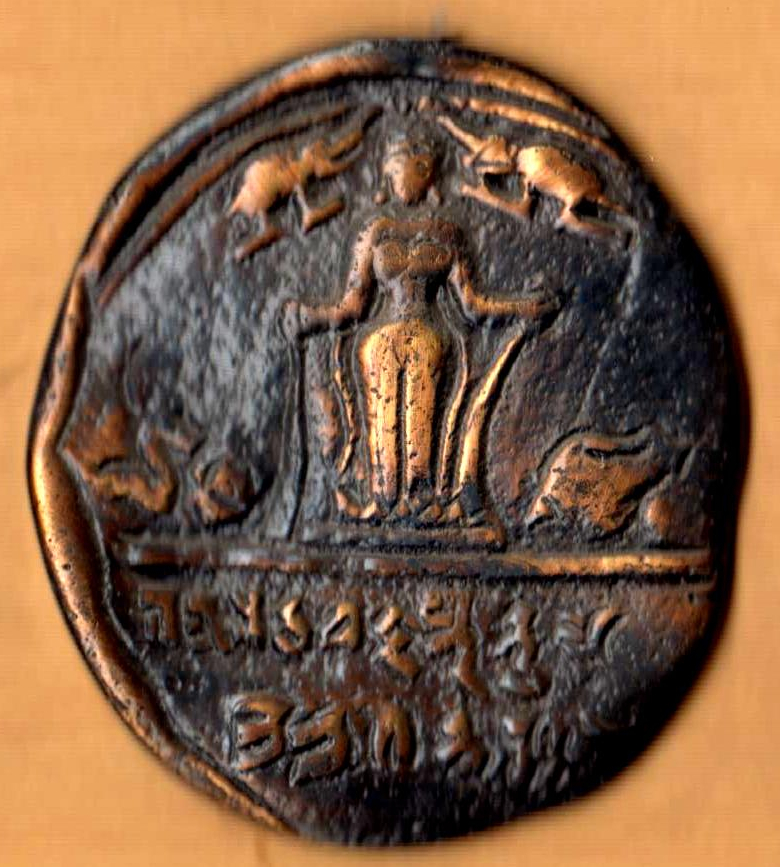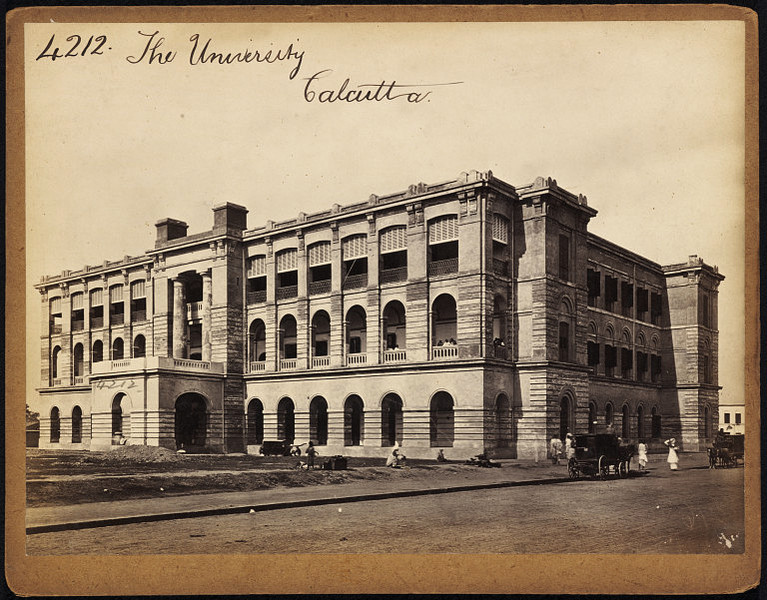|
Kalashoka
Kalashoka or Kakavarna was the son and successor of Shishunaga. He divided his kingdom between his ten sons and crowned his ninth son, Nandivardhana as the king of Magadha. Reign Shishunaga had transferred the capital of Magadha to Vaishali. Kalashoka succeeded his father Shishunaga. Kalashoka again transferred the capital to Pataliputra. According to Buddhist literature, the Second Buddhist Council Since the Mahaparinirvana of the historical Buddha, Siddhartha Gautama, Buddhist monastic communities, the "''sangha''", have periodically convened for doctrinal and disciplinary reasons and to revise and correct the contents of the Buddhist ..., held 100 years after the Maha Parinirvana of Lord Buddha, in Vaishali, was patronised by King Kalashoka. But despite King Kalashoka's best efforts, differences among the Buddhists persisted. He divided his kingdom between his ten sons, who ruled simultaneously. References Citations Sources * * * 4th-century BC Indian mon ... [...More Info...] [...Related Items...] OR: [Wikipedia] [Google] [Baidu] |
Shishunaga Dynasty
The Shaishunaga dynasty (IAST: Śaiśunāga, literally "of Shishunaga") was possibly the second ruling dynasty of Magadha. According to the Buddhist text Mahavamsa, this dynasty was the second ruling dynasty of Magadha, succeeding Nagadashaka of the Haryanka dynasty. The Hindu ''Puranas'' have given a different list with different chronology of the Shaishunaga dynasty kings, whereas Jain texts do not mention this dynasty. History Shishunaga was the founder of the dynasty. He was initially an ''amatya'' or "minister" of the last Haryanka dynasty ruler Nāgadāsaka and ascended to the throne after a popular rebellion in . The capital of this dynasty initially was Vaishali; but later shifted to Pataliputra, near the present day Patna, during the reign of Kalashoka. According to tradition, Kalashoka was succeeded by his ten sons. This dynasty was succeeded by the Nanda dynasty in . Historicity Jain texts have skipped over the Shaishunaga dynasty. They mention instead that ... [...More Info...] [...Related Items...] OR: [Wikipedia] [Google] [Baidu] |
Shishunaga
Shishunaga (IAST: Śiśunāga, or Shusunaga) ( – 395 BCE) was the founder of the Shishunaga dynasty of the Magadha Empire in the present day northern India. Initially, he was an ''amatya'' (official) of the Magadha empire under the Haryanka dynasty. He was placed on the throne by the people who revolted against the Haryanka dynasty rule. According to the Puranas, he placed his son at Varanasi and himself ruled from Girivraja (Rajagriha). He was succeeded by his son Kalashoka (Kakavarna). Early life According to the ''Mahavamsatika'', Shishunaga was a son of a Licchavi ruler of Vaishali. He was conceived by a ''nagara-shobhini'' and brought up an officer of state. At the time of the revolt, he was a viceroy at Varanasi of king Nagadasaka, the last ruler of the Haryanka dynasty. Reign Shishunaga ruled from 413 BCE to 395 BCE. Initially, his capital was Rajagriha and Vaishali was his second royal residence. Later he shifted his capital to Vaishali. He conquered Avanti king ... [...More Info...] [...Related Items...] OR: [Wikipedia] [Google] [Baidu] |
List Of Monarchs Of Magadha
The Kingdom of Magadha, later known as the Magadha Empire, was a kingdom and later empire in ancient north India. Many houses ruled the kingdom and its empire over the centuries until it was defeated by the Satavahana Empire in . The history of the monarchs of Magadha, particularly in the Pre-Mauryan period, is shrouded in mystery and legend with various sources claiming different things. House of Brihadratha The Brihadratha dynasty was the first ruling house of Magadha. Brihadratha founded this dynasty in 1700 BCE. This dynasty lasted for more than ten centuries, ruling Magadha from 1700 to 682 BCE. List of monarchs Twenty-one kings of Brihadratha house ruled Magadha, beginning with Brihadratha himself. House of Haryanka The Haryanka dynasty was the third ruling house of Magadha. This dynasty was founded by Bimbisara in 544 BCE. This dynasty lasted for 131 years, ruling Magadha from 544 to 413 BCE. List of monarchs This dynasty had six monarchs. House ... [...More Info...] [...Related Items...] OR: [Wikipedia] [Google] [Baidu] |
Second Buddhist Council
Since the Mahaparinirvana of the historical Buddha, Siddhartha Gautama, Buddhist monastic communities, the "''sangha''", have periodically convened for doctrinal and disciplinary reasons and to revise and correct the contents of the Buddhist canons. Referred to as Buddhist "councils" (Pāli and Sanskrit: ''saṅgīti'', literally meaning "reciting together" or "joint rehearsal"), the famous First Buddhist Council is recorded in Buddhist texts as being held one year after the Buddha's passing, when Ananda recited all of the spoken sutras, which were recorded in Rajagriha. The two next major Councils were held more than 100 years later. The details of the later councils are debated by modern Buddhist studies. Various sources belonging to different Buddhist schools may contain different accounts of these events. First Buddhist council All six of the surviving Vinaya sources of various early Buddhist schools contain accounts, in whole or in part, of the first and second co ... [...More Info...] [...Related Items...] OR: [Wikipedia] [Google] [Baidu] |
Magadha (Mahajanapada)
Magadha was a region and kingdom in ancient India, based in the eastern Ganges Plain. It was one of the sixteen Mahajanapadas during the Second Urbanization period. The region was ruled by several dynasties, which overshadowed, conquered, and incorporated the other Mahajanapadas. Magadha played an important role in the development of Jainism and Buddhism and formed the core of the Maurya Empire (ca. 320–185 BCE). Geography The territory of the Magadha kingdom proper before its expansion was bounded to the north, west, and east respectively by the Gaṅgā, Son, and Campā rivers, and the eastern spurs of the Vindhya mountains formed its southern border. The territory of the initial Magadha kingdom thus corresponded to the modern-day Patna and Gaya districts of the Indian state of Bihar. The region of Greater Magadha also included neighbouring regions in the eastern Gangetic plains and had a distinct culture and belief. History Vedic period (semi-legendary) (ca. 170 ... [...More Info...] [...Related Items...] OR: [Wikipedia] [Google] [Baidu] |
Vaishali (ancient City)
Vaishali, Vesali or Vaiśālī was an ancient city located north of Patna in present-day Bihar, India. It is now a Buddhist pilgrimage site that also contains two important stupas of the Buddha,Robert Beer, ''The Encyclopaedia of Tibetan Symbols and Motifs''. Boston: Shambhala, 1991. the '' Relic Stupa of Vaishali'' and the ''Stupa of Complete Victory''. As an archaeological site it forms part of the Vaishali District in Tirhut Division. It was the capital city of the Vajjika League of Vrijji mahajanapada, considered one of the first examples of a republic that dates from c.6th century BCE. Gautama Buddha preached his last sermon before his mahaparinirvana in , and Vaishali is also home to two important stupas directly related to the Buddha, the Relic Stupa of Vaishali, which is said to contain the ashes of the Buddha, and the ''Stupa of Complete Victory'' that represents the prolongation of the Buddha's life by three months when he was eighty years old. In 383 BCE the Secon ... [...More Info...] [...Related Items...] OR: [Wikipedia] [Google] [Baidu] |
University Of Calcutta
The University of Calcutta, informally known as Calcutta University (), is a Public university, public State university (India), state university located in Kolkata, Calcutta (Kolkata), West Bengal, India. It has 151 affiliated undergraduate colleges and 16 institutes in Kolkata and nearby areas. It was established on 24 January 1857 and is the oldest multidisciplinary university of Indian Subcontinent and Southeast Asian Region. Today, the university's jurisdiction is limited to a few districts of West Bengal, but at the time of its establishment it had a catchment area ranging from Kabul to Myanmar. It is accredited as an "A" grade university by the National Assessment and Accreditation Council (NAAC). The university has a total of fourteen campuses spread over the city of Kolkata and its suburbs. As of 2020, 151 colleges and 21 institutes and centres are affiliated with CU. The university was fourth in the Indian University Ranking 2021 list, released by the National Institu ... [...More Info...] [...Related Items...] OR: [Wikipedia] [Google] [Baidu] |
Calcutta
Kolkata, also known as Calcutta (List of renamed places in India#West Bengal, its official name until 2001), is the capital and largest city of the Indian States and union territories of India, state of West Bengal. It lies on the eastern bank of the Hooghly River, west of the border with Bangladesh. It is the primary Financial centre, financial and Commercial area, commercial centre of Eastern India, eastern and Northeast India, northeastern India. Kolkata is the list of cities in India by population, seventh most populous city in India with an estimated city proper population of 4.5 million (0.45 crore) while its metropolitan region Kolkata Metropolitan Area is the List of million-plus agglomerations in India, third most populous metropolitan region of India with a metro population of over 15 million (1.5 crore). Kolkata is regarded by many sources as the cultural capital of India and a historically and culturally significant city in the historic Bengal, region of ... [...More Info...] [...Related Items...] OR: [Wikipedia] [Google] [Baidu] |
Motilal Banarsidass
Motilal Banarsidass Publishing House (MLBD) is an Indian academic publishing house, founded in Delhi, India in 1903. It publishes and distributes serials, monographs, and scholarly publications on Asian religions, Buddhology, Indology, Eastern philosophy, history, culture, arts, architecture, archaeology, language, literature, linguistics, musicology, mysticism, yoga, tantra, occult, medicine, astronomy, and astrology. Amongst its publications are the 100 volumes of the Mahapuranas; the 50 volumes of the '' Sacred Books of the East'', edited by Max Müller; ''Bibliotheca Buddhica'' (30 volumes in 32 pts); Ramcharitmanas with Hindi and English translations; the Manusmriti in 10 volumes and the Sanskrit lexicon; and the 7 volumes of ''Encyclopedia of Indian Philosophies''. It also brings out books based on research and study conducted at organizations such as the Indian Council of Historical Research (ICHR), Indira Gandhi National Centre for the Arts (IGNCA), and Indian Cou ... [...More Info...] [...Related Items...] OR: [Wikipedia] [Google] [Baidu] |
4th-century BC Indian Monarchs
The 4th century was the time period from 301 CE (represented by the Roman numerals CCCI) to 400 CE (CD) in accordance with the Julian calendar. In the West, the early part of the century was shaped by Constantine the Great, who became the first Roman emperor to adopt Christianity. Gaining sole reign of the empire, he is also noted for re-establishing a single imperial capital, choosing the site of ancient Byzantium in 330 (over the current capitals, which had effectively been changed by Diocletian's reforms to Milan in the West, and Nicomedeia in the East) to build the city soon called Nova Roma (New Rome); it was later renamed Constantinople in his honor. The last emperor to control both the eastern and western halves of the empire was Theodosius I. As the century progressed after his death, it became increasingly apparent that the empire had changed in many ways since the time of Augustus. The two-emperor system originally established by Diocletian in the previous century fel ... [...More Info...] [...Related Items...] OR: [Wikipedia] [Google] [Baidu] |
Kings Of Magadha
Kings or King's may refer to: *Kings: The sovereign heads of states and/or nations. *One of several works known as the "Book of Kings": **The Books of Kings part of the Bible, divided into two parts **The ''Shahnameh'', an 11th-century epic Persian poem **The Morgan Bible, a French medieval picture Bible **The Pararaton, a 16th-century Javanese history of southeast Asia *The plural of any king Business *Kings Family Restaurants, a chain of restaurants in Pennsylvania and Ohio *Kings Food Markets, a chain supermarket in northern New Jersey * King's Favourites, a brand of cigarettes *King's Variety Store, a chain of stores in the USA *King's (defunct discount store), a defunct chain of discount stores in the USA Education *King's College (other), various colleges * King's School (other), various schools * The King's Academy (other), various academies Electoral districts *King's (New Brunswick federal electoral district) (1867–1903) *Kings (Nova Scoti ... [...More Info...] [...Related Items...] OR: [Wikipedia] [Google] [Baidu] |








